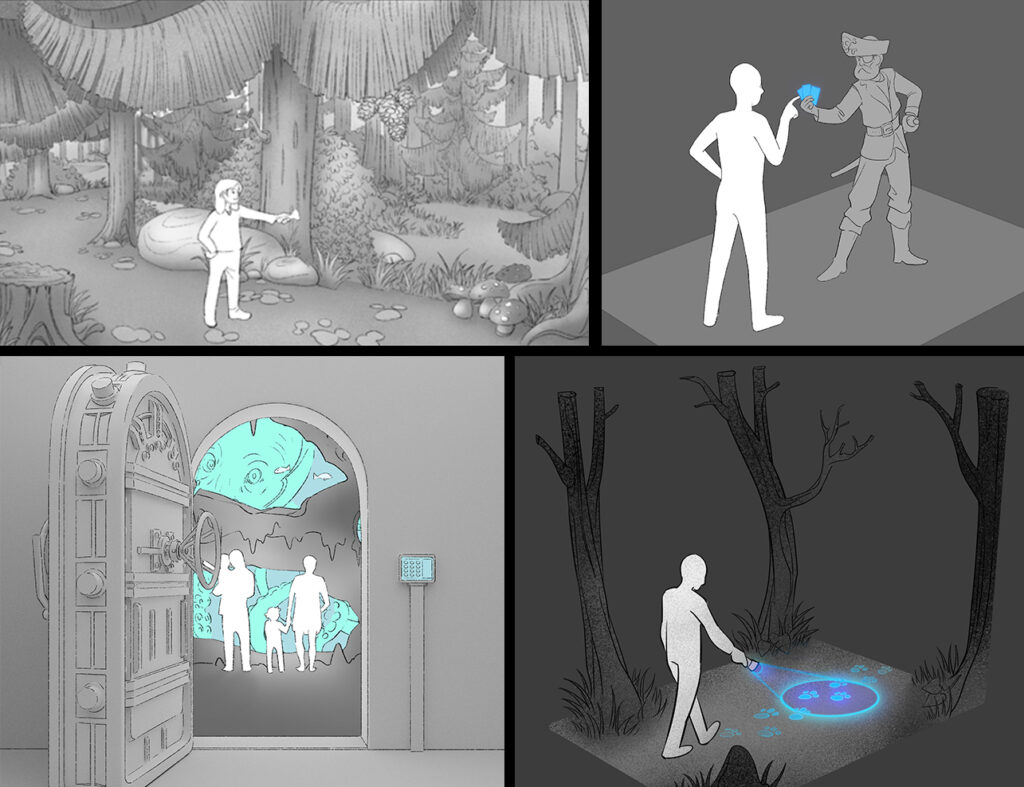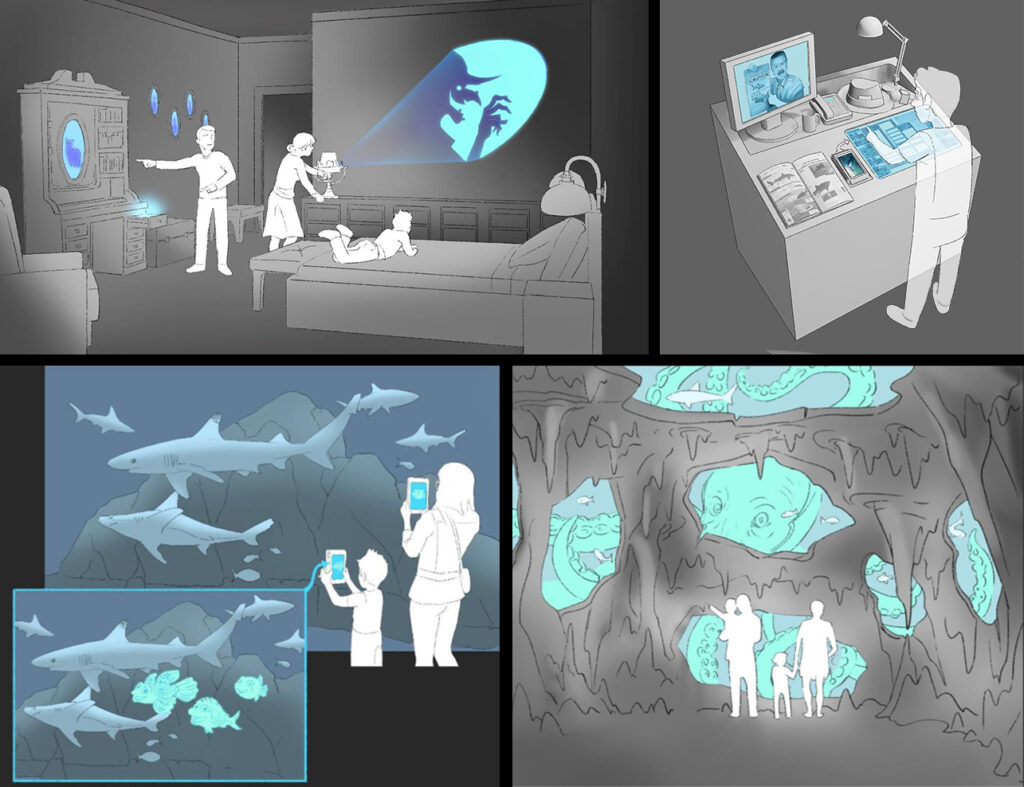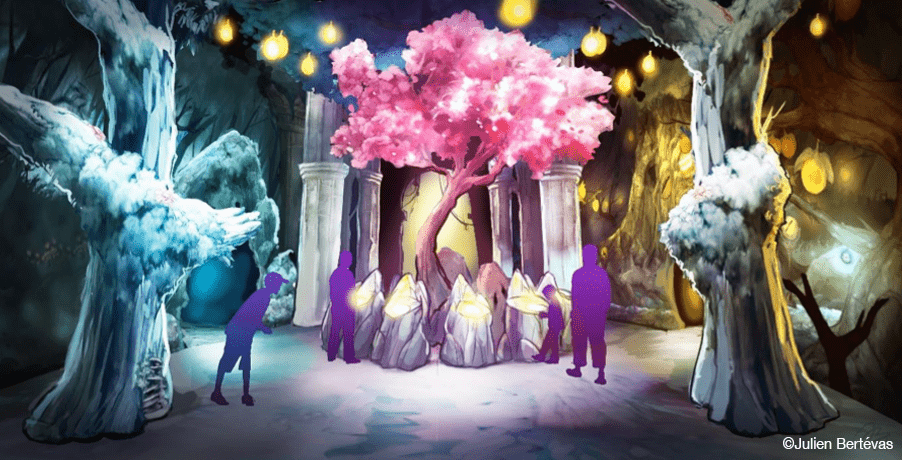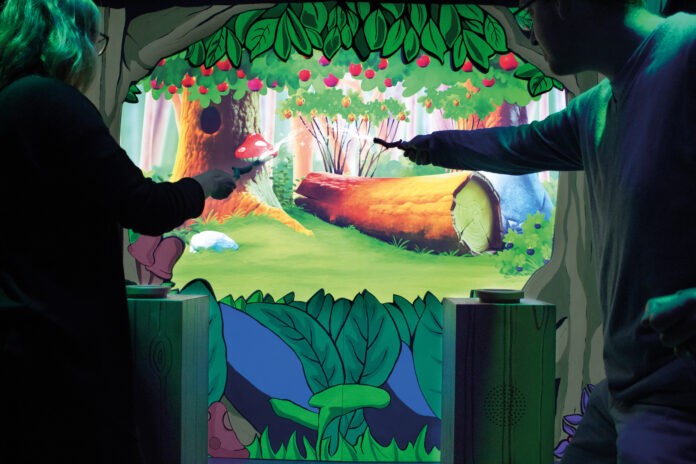Alterface makes a quantum leap: The Wander
by Gene Jeffers
In his “Dictionary of Obscure Sorrows,” John Koenig coined the term “Werifesteria,” meaning to wander through the forest in search of new mysteries, adventures or discoveries. No map, no set path to follow. Only your instincts and interests driving you to choose this trail or that, to stop and ponder over something of interest, moment by moment building your own unique narrative for the day.
Imagine a future when designers and operators can offer that to guests, offer a seamless blend of online world and themed environment where guests roam effortlessly between the virtual and the real, each creating their own unique path through Arthurian legends or exploring discoveries in Louis Pasteur’s lab. Within such a magic forest of independent yet interlinked sensations and worlds, what dreams can be realized? What experiences will be possible? What stories can be created and treasured?
You don’t have to imagine any longer. That future is now. Well known for their SALTO™ show control system driving themed experiences worldwide, the mages of technology at Alterface have conjured The Wander, a smart and intuitive system for designing and activating comprehensive worlds within which visitors can play and explore at the same time.
Challenge accepted
“The venue-based attraction industry is always seeking new ways to give their guests deeper, richer experiences, from theme parks to museums and aquariums to branding centers. It has been asking for greater immersive capabilities, increased visitor personalization and connections to their visitors when not on site,” says Stéphane Battaille, CEO of Alterface. “We met with a number of designers and operators and discussed their hopes, their visions of the future and found they all had come to the same conclusion we had: that something was desperately needed to take venue-based attractions to the next step and beyond. We knew we had to develop the answer to their needs.”
The team’s evolving brief for The Wander soon became daunting: Build a system that would empower designers to intuitively design stories for multiple days of adventures and that could manage thousands of players at the same time. The user interface would have to be easy to master for a creative team familiar with classic design tools. It should be able to deploy story content on new or existing technology across a wide range of venues. The system must have the capability to power stations with a wide range of interactivity (live actors, physical puzzles, shooting on a screen, motion tracking, etc.). Activity logs of visitors, their special status, next adventures to discover, changes in their world since their last visit, history of their actions had to be maintained. Most important, it must “understand” the behavior of each visitor and improve their story as well as create additional content. In other words, create a highly compatible, totally flexible master storytelling engine.
“It was challenging,” admits Etienne Sainton, Head of Software Engineering and Product Manager at Alterface. “And now we have a system that ticks those boxes and more.”
An interactive storyteller
“This is a tool for every designer, a tool to empower creativity,” Battaille says. “We designed it as an open source product, compatible with existing and future show control systems, to ensure maximum flexibility for designers and operators. We designed it to go well beyond current software capabilities.”
Sainton emphasizes the uniqueness of the new system. “This is the first technology that ‘industrializes’ the creation of and manages the entire life of experiences, from design to implementation in a venue. The Wander is a software tool to create and activate stories in the mind of designers.” He notes a number of advances in communication and data management – such as 5G, AI processing and large-scale data management – have been essential for the creation of The Wander. “But it required more, much more than those improved technologies,” he says. “We studied concepts and techniques from the video game industry, which has had massive multiplayer online role- playing games for years. We had to offer designers and operators the means to adapt those approaches to physical environments.”
To accomplish this required addressing a myriad of physical/ environmental limitations as well as developing standardized software layers and communication channels capable of managing an as-yet undefined range of interactive elements and ever-evolving content for each application. All while ensuring that the guest experience would be profitable for the operator.
“This had to be different, had to be more than what has already been done. Multiple activation and full-scale, LARP-styled interaction have already been created for themed venues or brand representation,” says Sainton. “Those attractions have to be manually written, played by actors who have to learn texts or clues. These complexities limit the scope of such adventures and add significantly to the cost. We wanted to go beyond, to make it possible for designers to expand the worlds in which visitors explore and play, expand the interactions between players, expand the paths they can follow, the stories they can create. We wanted to increase the potential for guests to return again and again, continuing their story and growing with each new adventure and discovery.”
“We knew we had to offer a wide range of services to designers and clients, large or small,” Battaille adds. “Initial, small-scale applications will help establish proof of concept. But The Wander is completely scalable up to an entire theme park hosting thousands of visitors daily.” Barely “out of the box,” The Wander already is inspiring the industry to think of exciting applications for this new system.
“The Wander, as a concept and now as a product, is an interactive storyteller, a story engine,” Sainton says. “It is already changing the way designers and fabricators approach installations. It will alter the way guests experience an attraction, whether exploring Tut’s tomb as an archaeologist or fighting a battle against an alien enemy as a star soldier.”
Implementation with Storyland and Ubisoft
A number of discussions are underway to apply The Wander’s potential in a range of environments, from theme parks to FECs, from a small family zoo to a motorsport facility. “Each customer will be provided with a unique package tailored to their needs,” says Battaille. “This is an entirely new product, one that is incredibly flexible. We want to inspire designers, motivate operators. We want them to think about possibilities and create new experiences for guests. This is happening now!”
“We’d begun a conversation with Alterface at a conference,” says Ben Thompson, Storyland Studios Chief of Strategy and Head of International. “They had a new software package that would take venue-based, immersive experiences to entirely new levels. Would Storyland be interested in partnering up to create a concept?”
The answer was yes, of course.



Image courtesy of Storyland Studios and Ubisoft
“Here at Storyland we’ve been looking closely at the gaming market for some time, and sooner rather than later, how it will permeate the theme park world,” says Thompson. What has been missing thus far was the technology to make that happen. “We immediately saw that this new software engine from Alterface had the capability to efficiently enable the online gaming experience within a themed environment and that it could seamlessly integrate that experience with a virtual game itself,” Thompson says.
As the two companies discussed the potential of The Wander and what stories/IP to which it might be applied, it became clear that Ubisoft would be the ideal IP partner to approach. “The settings within Ubisoft’s game worlds are a perfect tapestry for physical world creation – whether historic, real-life, city-based, under the ocean, or on a different planet. For Storyland, it’s an incredibly exciting sandbox to play in,” Thompson says. It did not take long for the design firm and the gaming giant to agree on a partnership.
“Working together, Ubisoft and Storyland will be creating themed environments you can play. All thanks to Alterface, who developed this amazing technology and, equally important, made the introductions,” says Thompson. “After all, this is an industry based on relationships!”
In creating The Wander, Alterface has now made it possible for guests to explore a themed environment in a “Werifesterian” way, each guest creating a story that grows and becomes far greater than the sum of its parts.
“That is what we hope for, that creation of rich, fluid experiences within which guests can wander, immerse themselves, find new paths, create stories and be a part of a larger whole,” says Battaille with a smile. “We are just beginning to understand how far The Wander will take people into that magical blend of the virtual and the real. The opportunity for designers and clients to offer attractions in this new way is limited only by their imaginations. Three years ago when we first began to think about what has now become The Wander, we wondered if we were crazy. Today, we see this is exactly what the attractions industry has been seeking for some time now. If they try it, if they test it, we know they will see even more potential for The Wander than we have imagined.”
Visit alterface.com.• • •






